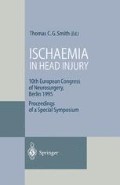Abstract
Professor Cohadon talked about the mechanisms and pathophysiology of ischaemic damage, and Dr Dearden presented evidence that these events occur in patients. These insults leave their mark on the brain and are detected both at post-mortem (which has been known for a long time) and using modern ways of detecting ischaemic insults, in living patients.
Access this chapter
Tax calculation will be finalised at checkout
Purchases are for personal use only
Preview
Unable to display preview. Download preview PDF.
Editor information
Editors and Affiliations
Rights and permissions
Copyright information
© 1996 Springer-Verlag Berlin Heidelberg
About this paper
Cite this paper
Teasdale, G. (1996). Pathological and Clinical Evidence of Ischaemic Damage in Brain Trauma. In: Smith, T.C.G. (eds) Ischaemia in Head Injury. Springer, Berlin, Heidelberg. https://doi.org/10.1007/978-3-642-80172-3_3
Download citation
DOI: https://doi.org/10.1007/978-3-642-80172-3_3
Publisher Name: Springer, Berlin, Heidelberg
Print ISBN: 978-3-540-61002-1
Online ISBN: 978-3-642-80172-3
eBook Packages: Springer Book Archive

